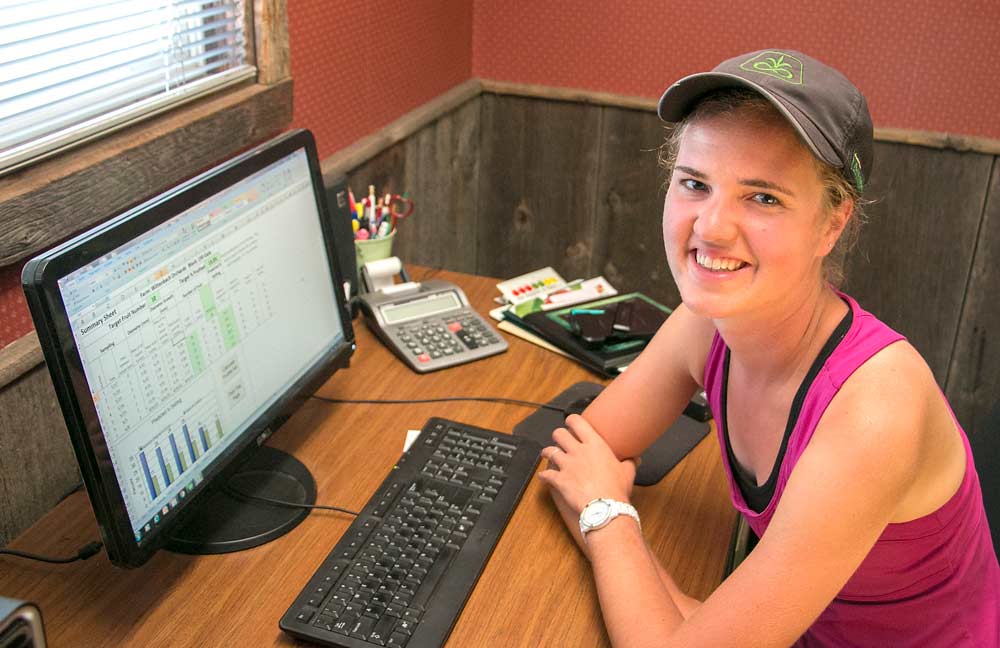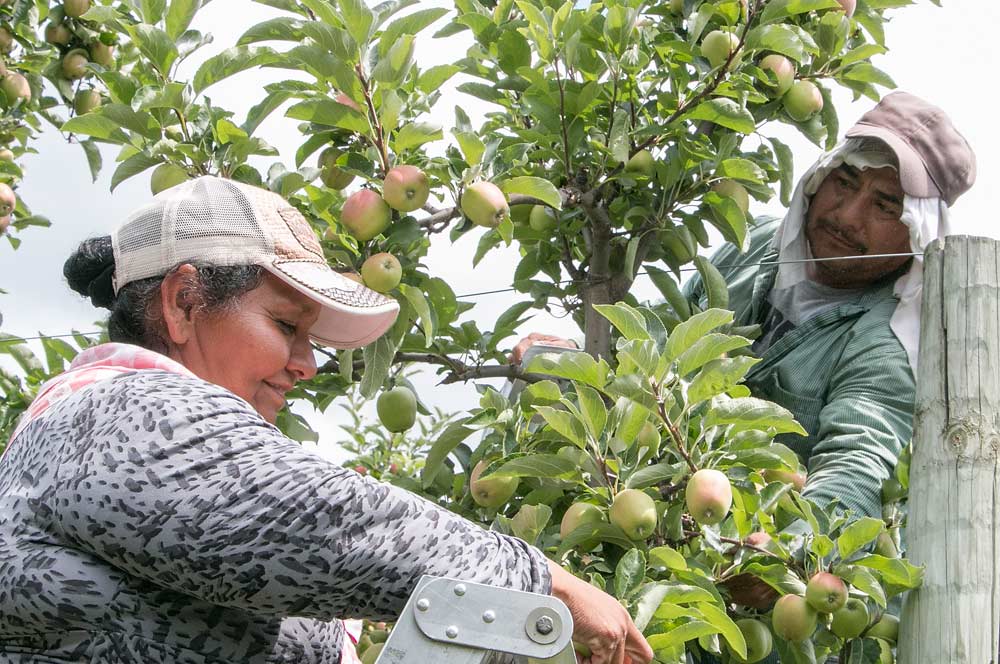
Elizabeth Wittenbach shows the precision crop load management model in her family’s farm office in July in Belding, Michigan. Wittenbach uses the spreadsheet to time the farm’s chemical thinning regimen, and — if things go according to plan — avoid the more expensive chore of hand thinning. (Ross Courtney/Good Fruit Grower)
In 2016, Elizabeth Wittenbach measured the development of her Gala fruitlets so precisely, her farm made it through the entire season with no hand thinning. Instead, the longtime family farm only applied some targeted chemical thinning, which is much cheaper.
Wittenbach, who marks the fifth generation at Wittenbach Orchards in Belding, is one of several Michigan growers to adopt a precision crop load management model that aims to guide chemical thinning by measuring the progress of fruit growth after bloom.
“Hopefully, then we never need to go through and hand thin,” she said.
Wittenbach explained her use of the model at one of her tour stops during the International Fruit Tree Association’s Summer Tour in July.
Here’s how it works.

Longtime employees Maria Reynoso and her husband, Roman Luna, thin Gala apples by hand, something they did not do at all last year thanks to Wittenbach’s precision crop load planning. This year, a spring frost and unusual weather at bloom threw off the plan.
(Ross Courtney/Good Fruit Grower)
Wittenbach uses a caliper to gently measure fruitlets, beginning about a week after full bloom, and enters the data onto a spreadsheet with her tablet.
Dotting the fruitlets with a Sharpie, she returns every three or four days to track the growth. The model will tell her how much of the fruit is likely to set within moments of her data entry.
If things go as planned, the family will use that information to spray targeted thinning agents early to set the right amount of fruit based on their targeted crop load — to “nibble away” at thinning, Wittenbach said, borrowing a term from her father Mike, who manages most of the farm operations.
This year, things didn’t go quite as planned. The region received a hard May frost combined with cool weather throughout bloom, prompting growers to hold off on chemical thinning until they could assess damage later in the year. The Wittenbachs still hand-thinned this year.
Last year was a different story. In 2016, Wittenbach was so spot on the family didn’t need to hand thin their Galas at all, saving about $40,000 in labor, Mike Wittenbach estimated.
Chemical thinning costs roughly $100 per acre, compared to between $800 to $1,500 per acre to hand thin, he said.
Wittenbach typically uses the model on Galas and Fujis, crops that are hard to thin, as well as Honeycrisps and some SweeTangos.
She recommends it for orchardists who like to spray early with multiple applications. For those who like to spray late, all at once, “I wouldn’t waste the time.”
The concept for the model is not new.
Duane Green of the University of Massachusetts and Terrence Robinson of Cornell University determined years ago that the fruitlets growing faster than 50 percent of the fastest growth rate will set. Those slower will abscise, or fall.
That has proven remarkably accurate over the past eight years or so, said Phil Schwallier, a Michigan State University extension horticulturist.
He and Green tested it in Michigan and began promoting it to area growers.
Many growers use it now, though the Wittenbachs were among the early adopters.
He warns growers to stick with the instructions and measure fruitlets from 15 clusters on five trees per block for a total of 75 clusters and 375 data points. He has heard of growers cutting down that sample size, which could lead to over or under thinning on years like 2017, “when Mother Nature throws you a lot of curve balls.”
Meanwhile, researchers elsewhere in the nation are working on using computer imaging to measure the fruitlet size, which could lead to a method that would allow growers to measure even larger sample sizes with less work and give more accurate predictions. •
– by Ross Courtney






Leave A Comment